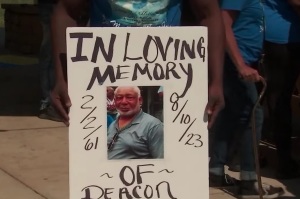The Accidental Author: Missionaries, Ruth Graham, and Beyond
Jim Elliot, one of five men who in 1956 were speared to death by Waorani Indians, is the most famous American missionary of the twentieth century. He and his colleagues longed to bring the gospel to this fierce and isolated Amazonian people.
His wife Elisabeth was taking care of their ten-month old daughter back at their mission station at the time. Jim and Elisabeth had met as students at Wheaton College. They were both Classical Greek majors and would study together in the east wing of Blanchard Hall. Their relationship deepened as Jim came more and more to rely on her to help him translate Thucydides.
Wheaton College was itself a kind of curious wonder in the mid-twentieth century. The other historic liberal arts colleges by then had mostly diluted or shed altogether their Christian identities. Wheaton, however, was fervently evangelical. Its students were on fire to make their lives count "for Christ and His Kingdom." There were many other Christian colleges with no less spiritual fervor, but they were almost all Bible schools. At Wheaton, one would study not only the Bible but also chemistry and anthropology, ancient history and the new physics. And one would learn to write well.
A widow and single mother at the age of 29, Elisabeth's response to her grief was to sit down and write. In the year following Jim's death her book about the tragedy appeared, Through Gates of Splendor (1957). It was a gripping, powerful narrative which was inspiring without veering off into sentimentality. It was also an immediate success, selling 175,000 copies in its first eight months. One year later, Elisbeth Elliot had a second highly popular book, Shadow of the Almighty (1958). Along with Rachel Saint – the sister of Nate Saint, one of the other slain men – Elisabeth did fulfill their dream of bringing the gospel to the Waorani. She lived among them in their remote world for two years.
Elisabeth's enduring ministry was not as a missionary, however, but rather as a writer. She went on to write more than a score of books in total, becoming for some years one of the most prominent figures in American evangelicalism. Elisabeth Elliot even wrote a novel that was surprisingly candid and searching about the failings and dilemmas of missionaries, No Graven Image (1966).
Variations on this pattern of a life have been repeated over and over again, most recently in the story of Todd and Lisa Beamer. Traveling for his work on September 11, 2001, Todd was on United Airlines Flight 93, one of the planes that was taken over by terrorists. He took a leading part in the group of passengers who bravely offered resistance. Through the actions of Todd and other heroic passengers the terrorists were unable to run the plane into a strategic site and thereby murder many more people. Instead, Flight 93 crashed in a field in Pennsylvania. Todd Beamer died on 9/11 at the age of 32. Lisa, five months pregnant with their daughter, was at home at the time with their two small boys.
Todd and Lisa had also met as Wheaton undergraduates. Immediately after the tragedy, Lisa quickly became a leading voice for those who had lost loved ones. She appeared on numerous shows such as Larry King Live and Oprah. America was comforted by her grace and eloquence. In the following year appeared her book, Let's Roll (2002). It went to number one on the New York Times bestseller list. Lisa worked in collaboration with a professional author, but the strength and felicity of her words in interviews and speeches makes it indisputable that she too had learned how to write well.
Moreover, the pattern existed long before five missionaries were killed on the Curaray River. Twenty years before Jim and Elisabeth, Kenneth Landon was a student at Wheaton College. He became engaged to Margaret Mortensen in 1924 which was her junior and his senior year. After their marriage, Kenneth became a Presbyterian missionary to what is today Thailand. While he traveled the country preaching and planting churches, Margaret Landon was at home running a girl's school and raising their four children. She was also thinking, reading and learning. The fruit of this labor was her book, Anna and the King of Siam (1944). It was an instant bestseller, going on to sell over a million copies. Rodgers and Hammerstein then turned it into a hit musical, "The King and I."
Five years before the undergraduate days of Jim and Elisabeth Elliot, Billy Graham had met Ruth Bell at Wheaton College. They were both graduated in 1943 and married that same summer. What unfolded thereafter was not the life that Ruth had imagined for herself. Billy's evangelistic work meant that he was frequently away, often out of the country for months at a time. She kept the home fires crackling in Montreat, North Carolina, and raised their three daughters and two sons. Ruth once pointedly remarked that she had tremendous sympathy for single-parent mothers because she knew from personal experience how hard it is to raise children on one's own.
All the while she was also writing poetry. When this passion was finally made public, Ruth explained that at college she had "discovered many of the great classical poets." She was not a widow, but her husband was absent, and writing also became for her a way to response to the difficult situation she found herself in. Ruth confessed, "I wrote because, at times, I had to. It was write, or develop an ulcer." Her first collection of poems was published in 1977. Numerous books followed and Ruth Bell Graham built up a loyal and appreciative readership of her own.
If the pattern began before Elisabeth Elliot and continues into the twenty-first century, it is also true that Elisabeth was not the only woman among her contemporaries to fit it. One of her friends at Wheaton was Eleanor Vandevort. Vandevort did not find a husband at Wheaton – in fact, she never married – but she also responded with zeal to the call to foreign missions which was so strong for that generation. She became a Presbyterian missionary to the southern Sudan. After thirteen years on the field, however, this ministry came to an end in 1963 when foreign Christian workers were expelled from the country. One of her greatest contributions therefore ended up being her beautifully written study of the Nuer people, A Leopard Tamed (1968). Vandevort was actually living with her friend Elisabeth Elliot when she wrote it. They had both been Classical Greek majors and it is not hard to perceive when reading either A Leopard Tamed or Elliot's No Graven Images (which is from this same period), that although the author may never have intended to become a writer, she has been liberally educated and therefore was well prepared to do so when the time came.
Wheaton College has no exclusive patent on this magic formula, of course. There is something special, however, about the potent blend of liberal arts with dedication to Christ. Catherine Wood found this vital combination at Agnes Scott College, a Presbyterian liberal arts institution of higher education for women in Decatur, Georgia. She was graduated in 1936 and married a minister, Peter Marshall, that same year. He was an enormously popular preacher, eventually gaining a national reputation as the chaplain of the United States Senate. Catherine's life became the demanding one of being a minister's wife and a mother. To this was added two extremely trying years when she was bedridden with tuberculosis.
The Reverend Peter Marshall died of a heart attack at the age of 46. Catherine responded to this engulfing loss by writing A Man Called Peter (1951). It stayed on the bestseller list for three years and was later turned into a successful feature film. Thereafter, Catherine Marshall was a writer. She wrote a score or more of books, including the bestselling novel, Christy, which became a TV series on CBS in the mid-1990s. Catherine Marshall's books have sold millions of copies.
It is not spiritually healthy to covet fame, while it is a Christian virtue to learn to be content with one's lot in life. Nevertheless, life has its seasons and therefore what God has in store for us in the future might look very different from our current lot. Many people whose lives might be bounded at the present by, for example, being care-givers or by prioritizing their spouse's career, know deep down inside themselves that they also have the education and talent to make a contribution well beyond their immediate circle should they ever be called upon to do so. A liberal arts education is training not for a specific career but for life as a whole – in all its fullness and unpredictably.
A simple prayer of dedication to serve in whatever way God wills often leads to unexpected bends in the road. While they thought of themselves as missionaries or mothers, when the time came, these women all found that they had the pen of a ready writer. She also serves who learns to write well.




























